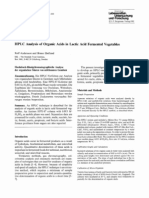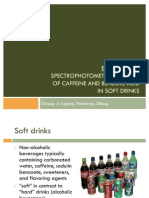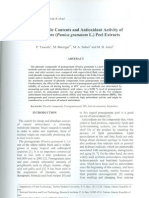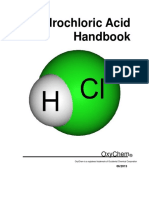Method For Quantitative Determination of Polyphenolic Compounds and Tannins From Vegetal Products
Method For Quantitative Determination of Polyphenolic Compounds and Tannins From Vegetal Products
Uploaded by
Andronicus KarisaCopyright:
Available Formats
Method For Quantitative Determination of Polyphenolic Compounds and Tannins From Vegetal Products
Method For Quantitative Determination of Polyphenolic Compounds and Tannins From Vegetal Products
Uploaded by
Andronicus KarisaOriginal Title
Copyright
Available Formats
Share this document
Did you find this document useful?
Is this content inappropriate?
Copyright:
Available Formats
Method For Quantitative Determination of Polyphenolic Compounds and Tannins From Vegetal Products
Method For Quantitative Determination of Polyphenolic Compounds and Tannins From Vegetal Products
Uploaded by
Andronicus KarisaCopyright:
Available Formats
Acta Universitatis Cibiniensis Seria F Chemia 8(2005-2):21-32
Method for Quantitative Determination of Polyphenolic Compounds and Tannins from Vegetal Products
I. Palici1, B. Tia1*, L. Urica1 and D. Tia1
Abstract The presence of polyphenolic compounds, tannoids and nontannoids, in vegetal products affects their therapeutic properties. In order to perform their quantitative determination, a method has been conceived which includes a series of chemical reactions, followed by a phase of spectrophotometric determinations and the processing of experimental data using a mathematical algorithm. The determination of total polyphenolic has been made using solutions of phosphowolframic acid and sodium carbonate as reactants. The percent of tannins is calculated after a preliminary quantitative determination of non-tannoids polyphenols, being equal to the difference between total polyphenols and non-tannoid polyphenols. The content in tannins has been expressed as tannic acid and pyrogallol [1, 2]. This work presents the analytical method and results obtained in analyzing 4 vegetal products. However, the method has been applied successfully in numerous other cases.
Keywords: polyphenolic compound, tannin, vegetal product.
Faculty of Pharmacy ,Victor Babe University of Medicine and Pharmacy, P-a .E Murgu No.2, 300041, Timisoara, Romania * To whom the correspondence should be addressed.
21
I. Palici, B. Tia, L. Urica and D. Tia
I. Introduction Tannins are present in vegetal products as complex mixtures in which predominate esters of some polyphenolic acids with glucids, in the case of hydrolysable tannins, or products of cathechin condensation, able to give steady, characteristic bounds, with the aminoacids from proteins structure [1]. In plants, macromolecular tannins are accumulated in ligneous tissues, barks and roots. In vegetal organs with intense physiological activity, tannins are found as smaller molecules. Tannins are present either dissolved in vacuolar sap of some parenchymatic cells as cortical parenchyma, secondary xylem and pith, or in specialised cells like idioblastes. Their biosynthesis is produced through the shikimic acid pathway [3]. Numerous vegetal products are appreciated for their antiseptic, hemostatic, antidiarrhoeic, antihemorroidal properties. Some tannins manifest P vitamin-like effects, regulating the resistance and the permeability of capillary vessels. For mint species it is estimated that tannins are responsible for antiseptic and antidiarrhoeic effects while nontannoid polyphenols are for the antispasmodic one [4]. Some polyphenolcarboxilic compounds have a role in the inhibition the biosynthesis of B4 leucotrien (LTB4), a fact which offers a serious reason for their utilisation in the treatment of allergic inflamations and asthma [5]. The determination of tannins from vegetal products is of special importance, in view their contribution to desired therapeutic actions. Numerous methods for the determination of tannins are known. The most important are the following [3]: a gravimetric method based on the precipitation of tannins with copper acetate colorimetric method Ionescu Popescu which consists of the treatment of a vegetal extract with a solution of tungsto-phosphoric acid followed by the discoloration of the resultant solution with potassium ferricyanide in a quantity to the tannin entered in the reaction skin powder method, based on a preliminary determination of the polyphenolic total, followed by adsorption of tannins on skin powder. Subsequently, the polyphenols remaining in solution are quantitatively determined. Tannins are determined by difference. The method proposed in this work represents a modified variant of skin powder method and consists of an indirect determination of tannins. In the first stage the polyphenolic total is determined. In the second stage, after the adsorption of tannins on standard skin powder, the nontannic polyphenols are determined in the filtered solution. II. Experimental Quantitative determination of tannins has been made using a spectrophotometric method. The spectrophotometer used was a JENWAY 6100. As reagents, tannic acid, tungstophosphoric acid, pyrogallol and natrium carbonate have been used. Since tannins are present in the vegetal products as complex mixtures of chemical structures we have 22
Acta Universitatis Cibiniensis Seria F Chemia 8(2005-2):21-32
used as reference two substances with tannoid properties, namely tannic acid and pyrogallol. These were used consecutively to construct the standard curves. In order to draw the standard straight line, ten solutions of tannic acid have been prepared with concentrations within the interval 0.001 % and 0.01 %, in steps of 0.001 %. 0.2 g of tannic acid have been weighed and completed with water to 20 g. A solution of 0.01 % tannic acid in water has resulted, which has been diluted according to Table 1. Table 1. Table of dilution for obtaining the standard concentrations of tannic acid. Volume of initial Volume of water used Concentration (m/m) in solution of tannic acid Solution number for dilution tannic acid of resulted 0,01 % [ml] solution [%] [ml] 0 standard 0.00 4.00 0.000 1 0.40 3.60 0.001 2 0.80 3.20 0.002 3 1.20 2.80 0.003 4 1.60 2.40 0.004 5 2.00 2.00 0.005 6 2.40 1.60 0.006 7 2.80 1.20 0.007 8 3.20 0.80 0.008 9 3.60 0.40 0.009 10 4.00 0.00 0.010 Solutions with concentrations between 0.001 and 0.01 percent, at intervals of 0.001 have been obtained and worked out as follows. 2 ml from each solution have been treated with 1 ml tungstophosphoric acid and 17 ml of natrium carbonate 50 % solution. After 120 seconds the absorbance at wavelength of 750 nm has been read. The absorbance has been determined using water as the standard. Values are presented in Table 2. A statistical evaluation of the values of absorbance was done, in order to eliminate values considered statistically unacceptable and also to identify and remove the terminal segments of the curve, which do not correspond to the criteria of application for Lambert Beers law. Hence, the angular coefficients for each segment of the curve have been calculated. Standard deviation for the row of values obtained has been determined and the elimination criterium for each value has been verified.
23
I. Palici, B. Tia, L. Urica and D. Tia
Table 2. Values of absorbance for standard straight line, used for the determination of polyphenolic compounds expressed in tannic acid.
Current number 0 standard 1 2 3 4 5 6 7 8 9 10 Concentration in tannic acid [%] 0.000 0.001 0.002 0.003 0.004 0.005 0.006 0.007 0.008 0.009 0.010 Absorbance 0.000 0.017 0.027 0.035 0.046 0.061 0.070 0.082 0.099 0.103 0.105
Individual values for each angular coefficient are calculated as follows: C Ci 1 Xi = i Ai Ai 1 where Ci and Ai represent individual values for concentration and absorbance. They are presented in Table 3. Table 3. Individual values of angular coefficients for the standard curve, used for the determination of polyphenolic compounds expressed in tannic acid. C Ci 1 Xi = i Current number Ai Ai 1 1 0,0588 2 0,100 3 0,125 4 0,0909 5 0,0667 6 0,111 7 0,0833 8 0,0588 9 0,250 10 0,500
24
Acta Universitatis Cibiniensis Seria F Chemia 8(2005-2):21-32
The formula for standard deviation is the following:
( xi x ) 2
s=
1
n 1
where s = standard deviation, xi = individual values for angular coefficients, x i = average of angular coefficients and n = number of elements in the studied row [6]. After the application of the elimination criteria, the last two values of the angular coefficient have been removed because (di = 0.355) > (s * x/s = 0.268), respectively (di = 0.145) > (s * x/s = 0.113). Therefore the standard straight line has the shape presented in Fig. 1.
0,09 0,08 0,07 0,06 0,05 0,04 0,03 0,02 0,01 0 0 0,002 0,004
Absorbance
y = 11,54x
0,006
0,008
Concentration in polyphenolic compounds [%]
Fig. 1. Standard straight line for quantitative determination of the polyphenolic compounds expressed in tannic acid.
For the preparation of the analytical solution, 0.5 g of finely pulverized vegetal product has been put in a balloon flask of 250 ml, together with 150 ml water and boiled for 30 minutes under an ascending condenser. The mixture was then cooled under a water stream, diluted with water to 250 ml and filtered through a filter paper. 5 ml of filtrate has been diluted with water to 25 ml. 2 ml of the resultant solution has been treated with 1 ml tungsto-phosphoric acid (R) and 17 ml of natrium carbonate 50 % solution. After 120 seconds, the absorbance has been read at wavelength 750 nm, using water as a standard [7]. In this case, the quantitative determination of the polyphenolic compounds in dry vegetal products has taken into account the following:
25
I. Palici, B. Tia, L. Urica and D. Tia
5 ml filtered solution corresponds to (0.5/250) * 5 = 0.01 g dry vegetal product after completion with water of 5 ml filtered solution to 25 ml, 1 ml of assay solution corresponds to 0.01/25 = 0.0004 g dry vegetal product, having a concentration of 0.04 % after the quantitative determination of the polyphenolic compounds in assay solutions, by extrapolation from the regression straight line, the content of the polyphenolic compounds in dry vegetal product, expressed in tannic acid, has been calculated applying the following formula:
C TT % =
where
100 * abs 1 11.54 * 0.04
CTT % is the total polyphenolic percent in the dry vegetal product, expressed in tannic acid, and abs1 is the absorbance indicated by spectrophotometer for the quantitative determination of the total polyphenolic compounds.
According to the previous formula, the function of absorbance obtained for the solution corresponding to each vegetal product, the percent of polyphenolic compounds, expressed in tannic acid, in dry the vegetal product has been calculated [8, 9]. The content of polyphenolic compounds can be expressed also in pyrogallol. In order to perform this operation, a standard curve has been drawn by determining the absorbances for a series of standard solutions of pyrogallol, with concentration between 0.001 % to 0.01 % in steps of 0.001 %. These solutions have been obtained after the dilution with water of a solution of 0.01 % pyrogallol according to Table 4.
Table 4. Table of dilution for obtaining standard concentrations of pyrogallol. Volume of initial Volume of water used Concentration (m/m) in solution of pyrogallol Solution number for dilution pyrogallol of resulted 0,01 % [ml] solution [%] [ml] 0 standard 0.00 4.00 0.000 1 0.40 3.60 0.001 2 0.80 3.20 0.002 3 1.20 2.80 0.003 4 1.60 2.40 0.004 5 2.00 2.00 0.005 6 2.40 1.60 0.006 7 2.80 1.20 0.007 8 3.20 0.80 0.008 9 3.60 0.40 0.009 10 4.00 0.00 0.010 26
Acta Universitatis Cibiniensis Seria F Chemia 8(2005-2):21-32
The values of the absorbance read for the series of standard solutions are presented in Table 5.
Table 5. Values of absorbance for standard straight line used at the determination of polyphenoliccompounds expressed in pyrogallol. Current number Concentration [%] Absorbance
1 2 3 4 5 6 7 8 9 10 0.001 0.002 0.003 0.004 0.005 0.006 0.007 0.008 0.009 0.010 0.009 0.019 0.028 0.039 0.049 0.061 0.069 0.080 0.087 0.091
A statistic evaluation has been performed in order to eliminate values considered statistically unacceptable, and also to identify and remove the terminal segments of the curve which do not correspond to the criteria of application for Lambert Beers law. The individual values for each angular coefficient have been determined. They are presented in Table 6.
Table 6. Individual values of angular coefficients for the standard curve used for the determination of polyphenolic compounds expressed in pyrogallol. C Ci 1 Xi = i Current number Ai Ai 1 1 0,111 2 0,100 3 0,111 4 0,0909 5 0,100 6 0,0833 7 0,125 8 0,0909 9 0,143 10 0,250
27
I. Palici, B. Tia, L. Urica and D. Tia
After the application of the elimination criteria, the last two values of the angular coefficient must be removed because (di = 0.130) > (s * x/s = 0.0957), respectively (di = 0.0367) > (s * x/s = 0.0360). Therefore the standard straight line has the shape presented in Fig. 2.
0,08 0,07 0,06 0,05 0,04 0,03 0,02 0,01 0 0 0,002 0,004 0,006 0,008
Absorbance
y = 10,19x
Concentration in polyphenolic compounds [%]
Fig. 2. Standard straight line for quantitative determination of polyphenolic compounds expressed in pyrogallol.
Applying the previous reasoning, the concentration of the polyphenolic compounds, expressed in pyrogallol, has been calculated using the formula:
C TP % =
where
100 * abs 1 10.19 * 0.04
CTP % is the total polyphenolic percent in the dry vegetal product, expressed in pyrogallol, and abs1 is the absorbance indicated by spectrophotometer for the quantitative determination of the total polyphenolic compounds.
According to the previous formula, depending on the absorbance obtained for the solution corresponding to each vegetal product, the percent of the polyphenolic compounds, expressed in pyrogallol, has been calculated for the dry vegetal product [8, 9]. The concentration in tannins has been established, after a preliminary quantitative determination of the nontannic polyphenols, according to the following algorithm. 10 ml of assay solution filtered previously has been stirred together with standard skin powder for 60 minutes. Subsequently the mixture has been filtered. In this case, only 28
Acta Universitatis Cibiniensis Seria F Chemia 8(2005-2):21-32
nontannic compounds remained in solution, while tannins have been absorbed on the skin powder. 5 ml of filtrate has been diluted with water to 25 ml. 2 ml of resulted solution has been treated with 1 ml tungstophosphoric acid (R) and 17 ml of natrium carbonate 50 % solution. After 120 seconds the absorbance has been read at wavelength 750 nm using water as a standard. Having in view the standard straight lines, presented in figures 1 and 2, in this stage, the two concentrations of nontannic polyphenols have been determined, expressed in tannic acid respectively in pyrogallol, using the following formulas:
CNT % =
where
100* abs2 11.54* 0.04
CNT % is the total polyphenolic percent in dry vegetal product, expressed in tannic acid, and abs2 is the absorbance indicated by spectrophotometer for the quantitative determination of the nontannic polyphenols
respective
C NP % =
where
100 * abs 2 10.19 * 0.04
CNP % is the total polyphenolic percent in dry vegetal product, expressed in pyrogallol, and abs2 is the absorbance indicated by spectrophotometer for the quantitative determination of the nontannic polyphenols. Finally, the percentage of tannins in the vegetal products has been calculated by difference. Percentage of tannins in dry vegetal product, expressed in tannic acid is: CT%= CTT%- CNT%
Percent of tannins in dry vegetal product, expressed in pyrogallol is:
CP%= CTP%- CNP%
29
I. Palici, B. Tia, L. Urica and D. Tia
III. Results and discussions
The percentage of total polyphenols, nontannic polyphenols and tannins in the vegetal products Herba, from species Ajuga reptans (bugleweed) and Mentha pulegium (pennyroyal) and Folium from species Mentha x piperita ( peppermint) and Mentha longifolia ( horse mint) has been determined [10]. The results are presented in Table 7. The values obtained for the quantitative composition of the polyphenolic compounds in the analysed products are close to those mentioned by other authors for the species from Lamiaceae. In this work, the quantitative determinations have shown a content in tannins from 4.85 to 11.70 percent, while in other scientific works the percent values of the tannins are between 7 %, in the vegetal product Herba from Ajuga reptans, and 20 % for the same product from species Glechoma hederacea. For the vegetal product Folium from Mentha x piperita, a percent of 12 % tannins is mentioned in the literature. It is important to mention that this variant of the skin powder method is specific for tannins with a relatively high degree of condensation, while the smaller molecules like chlorogenic and rosmarinic acid present a reduced affinity to the proteins from skin powder. The structures named generically tannins are chemically very heterogenous. Depending on their chemism, on the method of analysis, and on other factors like harvesting period, location, climatic conditions, there is a possibility that the value for the content of the reported tannin might be different from one scientific work to another. In this work, the values obtained are close to those reported by other authors [2, 11, 12, 13].
30
Acta Universitatis Cibiniensis Seria F Chemia 8(2005-2):21-32
Table 7. Percentage of total polyphenols, nontannic polyphenols and tannins of the vegetal products Herba, from species Ajuga reptans and Mentha pulegium, and Folium, from species Mentha x piperita and Mentha longifolia
31
I. Palici, B. Tia, L. Urica and D. Tia
IV. Conclusions
The method proposed for investigation proved to be facile and reliable. Determination of tannins requires a minimal set of materials and devices. The matemathic model used for the interpretation of the results is a verified one, very efficient and easy to apply. Based on the above mentioned facts and taking into account the concordance of obtained results with those reported in the scientific literature, the conclusion is that this work represents a step forward in the laborious activity involved in the elucidation of the chemical composition of vegetal products.
V. References
1. Popescu, H., Grecu, L., Cioac, C., Roca, M., Analiza chimic a produselor naturale medicinale, Lito IMF Cluj-Napoca, 1981. 2. Palici, I., Cercetri preliminare asupra unor grupe de compui chimici din lamiacee medicinale, Referat doctorat, 1998. 3. Ciulei, I., Grigorescu, E., Stnescu, U., Plante medicinale, fitochimie si fitoterapie, vol. 1, Editura Medical Bucureti, 1993. 4. Wagner, H., Pharmazeutische Biologie, Drogen und ihre Inhalts-stoffe, Gustav-Fischer Vlg., Stuttgart-New York, 1985. 5. Kimura, Y., Okula, H. , J. Nat. Prod., 1987, 50 (3), 392. 6. Tia, D., Chimie analitic cantitativ. Titrimetrie, Ed. Mirton, Timioara, 1998. 7.* * * Dozarea taninurilor din produsele vegetale, Farmacopeea roman, Ed. X-a, Editura Medical, Bucureti, 1993. 8. Palici, I. , Lamiacee medicinale din flora Banatului, Ph. D. Thesis, 2000. 9. Grimm, H., Analysis of regressions, Ed. Pergamo Press, 1973. 10. Ciocarlan, V., Flora Ilustrat a Romniei, Ed. Ceres, Bucureti, 2000. 11. Hoppe, H., Drogenkunde Walter de Gruyter,Berlin - New York, 1975. 12. Cannas, A., Tannins: Fascinating but Sometimes Dangerous Molecules, Cornell University, 1996. 13. Craciun, F., Bojor, O., Alexan, M., Farmacia naturii, vol. 2, Ed. Ceres, Bucureti, 1977.
32
You might also like
- USP Medicines Compendium - Etoricoxib - 2014-02-28 PDF67% (6)USP Medicines Compendium - Etoricoxib - 2014-02-28 PDF4 pages
- Extraction of Antioxidants From Vegetable BiomassNo ratings yetExtraction of Antioxidants From Vegetable Biomass24 pages
- Characterization and Measurement of Anthocyanins by UV-Visible SpectrosNo ratings yetCharacterization and Measurement of Anthocyanins by UV-Visible Spectros13 pages
- HPLC Analysis of Organic Acids in Lactic Acid Fermented VegetablesNo ratings yetHPLC Analysis of Organic Acids in Lactic Acid Fermented Vegetables4 pages
- Determination of Biophenols in Olive Oils by HPLCNo ratings yetDetermination of Biophenols in Olive Oils by HPLC8 pages
- Preparation and Characterization of Aloe Vera ExtractNo ratings yetPreparation and Characterization of Aloe Vera Extract7 pages
- Dioscorea Alata L Anthocyanin Extract Methanol AsNo ratings yetDioscorea Alata L Anthocyanin Extract Methanol As8 pages
- 108 - Determination of Benzoic Acid and Sorbic Acid-All Foods - SOPNo ratings yet108 - Determination of Benzoic Acid and Sorbic Acid-All Foods - SOP5 pages
- 2.9. in Vivo Activity Assays 2.9.1. The Inhibition of Lipid Peroxidation in Rat SerumNo ratings yet2.9. in Vivo Activity Assays 2.9.1. The Inhibition of Lipid Peroxidation in Rat Serum8 pages
- Archive of SID: Total Phenolic Contents and Antioxidant Activity of Pomegranate (Punica Granatum L.) Peel ExtractsNo ratings yetArchive of SID: Total Phenolic Contents and Antioxidant Activity of Pomegranate (Punica Granatum L.) Peel Extracts7 pages
- Determination of Bendamustine Hydrochloride in Pure and Dosage Forms by Ion-Associative Complex FormationNo ratings yetDetermination of Bendamustine Hydrochloride in Pure and Dosage Forms by Ion-Associative Complex Formation6 pages
- COI T.20 Doc. No 29 Rev 1 2017 BiophénolNo ratings yetCOI T.20 Doc. No 29 Rev 1 2017 Biophénol8 pages
- Practical 5: Analysis of Vitamin C Using HPLC ObjectitveNo ratings yetPractical 5: Analysis of Vitamin C Using HPLC Objectitve7 pages
- Biochemical Education - July 1992 - Sánchez Ferrer - A Simple Procedure For Purifying Polyphenol Oxidase For A PracticalNo ratings yetBiochemical Education - July 1992 - Sánchez Ferrer - A Simple Procedure For Purifying Polyphenol Oxidase For A Practical2 pages
- Determination and Validation of Mebhydroline NapadNo ratings yetDetermination and Validation of Mebhydroline Napad3 pages
- Measuring Trypsin Inhibitor in Soy MealNo ratings yetMeasuring Trypsin Inhibitor in Soy Meal19 pages
- Encapsulation of Anthocyanin and Flavonoid Watermelon RindNo ratings yetEncapsulation of Anthocyanin and Flavonoid Watermelon Rind6 pages
- Tannins Extraction From Walnuts ResiduesNo ratings yetTannins Extraction From Walnuts Residues6 pages
- Measuring Trypsin Inhibitor in Soy Meal - Suggested Improvements in Std. Method PDFNo ratings yetMeasuring Trypsin Inhibitor in Soy Meal - Suggested Improvements in Std. Method PDF7 pages
- By Using RP-HPLC Technique, Quantitative and Qualitative Analysis of Gallic Acid From Industrial WasteNo ratings yetBy Using RP-HPLC Technique, Quantitative and Qualitative Analysis of Gallic Acid From Industrial Waste4 pages
- Liquid Chromatographic Determination of Vitamins B1 and B2 in Foods.No ratings yetLiquid Chromatographic Determination of Vitamins B1 and B2 in Foods.6 pages
- GC Determination of Pantothenates and PanthenolNo ratings yetGC Determination of Pantothenates and Panthenol10 pages
- Industrial Training Presentation S 08 905No ratings yetIndustrial Training Presentation S 08 90546 pages
- Liposome Encapsulated Vitamin A Compounds Exhibit Greater Stability and Diminished ToxicityNo ratings yetLiposome Encapsulated Vitamin A Compounds Exhibit Greater Stability and Diminished Toxicity8 pages
- Study On The Methods of Carotene Extraction of Spirulina PlatensisNo ratings yetStudy On The Methods of Carotene Extraction of Spirulina Platensis7 pages
- 2.5.40. Methyl, Ethyl and Isopropyl Toluenesulfonate in Active SubstancesNo ratings yet2.5.40. Methyl, Ethyl and Isopropyl Toluenesulfonate in Active Substances2 pages
- Practical Handbook of Pharmaceutical Chemistry for M.PharmFrom EverandPractical Handbook of Pharmaceutical Chemistry for M.PharmNo ratings yet
- Sustainable synthesis of ciclopentene derivatives through multicomponent reactions in continuous flow regimeFrom EverandSustainable synthesis of ciclopentene derivatives through multicomponent reactions in continuous flow regimeNo ratings yet
- Chemesthesis: Chemical Touch in Food and EatingFrom EverandChemesthesis: Chemical Touch in Food and EatingShane T. McDonaldNo ratings yet
- Moi University: Main Campus School of Engineering Depertment of Chemical and Process Engineering100% (1)Moi University: Main Campus School of Engineering Depertment of Chemical and Process Engineering1 page
- USP Medicines Compendium - Etoricoxib - 2014-02-28 PDFUSP Medicines Compendium - Etoricoxib - 2014-02-28 PDF
- Characterization and Measurement of Anthocyanins by UV-Visible SpectrosCharacterization and Measurement of Anthocyanins by UV-Visible Spectros
- HPLC Analysis of Organic Acids in Lactic Acid Fermented VegetablesHPLC Analysis of Organic Acids in Lactic Acid Fermented Vegetables
- Preparation and Characterization of Aloe Vera ExtractPreparation and Characterization of Aloe Vera Extract
- 108 - Determination of Benzoic Acid and Sorbic Acid-All Foods - SOP108 - Determination of Benzoic Acid and Sorbic Acid-All Foods - SOP
- 2.9. in Vivo Activity Assays 2.9.1. The Inhibition of Lipid Peroxidation in Rat Serum2.9. in Vivo Activity Assays 2.9.1. The Inhibition of Lipid Peroxidation in Rat Serum
- Archive of SID: Total Phenolic Contents and Antioxidant Activity of Pomegranate (Punica Granatum L.) Peel ExtractsArchive of SID: Total Phenolic Contents and Antioxidant Activity of Pomegranate (Punica Granatum L.) Peel Extracts
- Determination of Bendamustine Hydrochloride in Pure and Dosage Forms by Ion-Associative Complex FormationDetermination of Bendamustine Hydrochloride in Pure and Dosage Forms by Ion-Associative Complex Formation
- Practical 5: Analysis of Vitamin C Using HPLC ObjectitvePractical 5: Analysis of Vitamin C Using HPLC Objectitve
- Biochemical Education - July 1992 - Sánchez Ferrer - A Simple Procedure For Purifying Polyphenol Oxidase For A PracticalBiochemical Education - July 1992 - Sánchez Ferrer - A Simple Procedure For Purifying Polyphenol Oxidase For A Practical
- Determination and Validation of Mebhydroline NapadDetermination and Validation of Mebhydroline Napad
- Encapsulation of Anthocyanin and Flavonoid Watermelon RindEncapsulation of Anthocyanin and Flavonoid Watermelon Rind
- Measuring Trypsin Inhibitor in Soy Meal - Suggested Improvements in Std. Method PDFMeasuring Trypsin Inhibitor in Soy Meal - Suggested Improvements in Std. Method PDF
- By Using RP-HPLC Technique, Quantitative and Qualitative Analysis of Gallic Acid From Industrial WasteBy Using RP-HPLC Technique, Quantitative and Qualitative Analysis of Gallic Acid From Industrial Waste
- Liquid Chromatographic Determination of Vitamins B1 and B2 in Foods.Liquid Chromatographic Determination of Vitamins B1 and B2 in Foods.
- Liposome Encapsulated Vitamin A Compounds Exhibit Greater Stability and Diminished ToxicityLiposome Encapsulated Vitamin A Compounds Exhibit Greater Stability and Diminished Toxicity
- Study On The Methods of Carotene Extraction of Spirulina PlatensisStudy On The Methods of Carotene Extraction of Spirulina Platensis
- 2.5.40. Methyl, Ethyl and Isopropyl Toluenesulfonate in Active Substances2.5.40. Methyl, Ethyl and Isopropyl Toluenesulfonate in Active Substances
- Practical Handbook of Pharmaceutical Chemistry for M.PharmFrom EverandPractical Handbook of Pharmaceutical Chemistry for M.Pharm
- Sustainable synthesis of ciclopentene derivatives through multicomponent reactions in continuous flow regimeFrom EverandSustainable synthesis of ciclopentene derivatives through multicomponent reactions in continuous flow regime
- Chemesthesis: Chemical Touch in Food and EatingFrom EverandChemesthesis: Chemical Touch in Food and Eating
- Moi University: Main Campus School of Engineering Depertment of Chemical and Process EngineeringMoi University: Main Campus School of Engineering Depertment of Chemical and Process Engineering































































